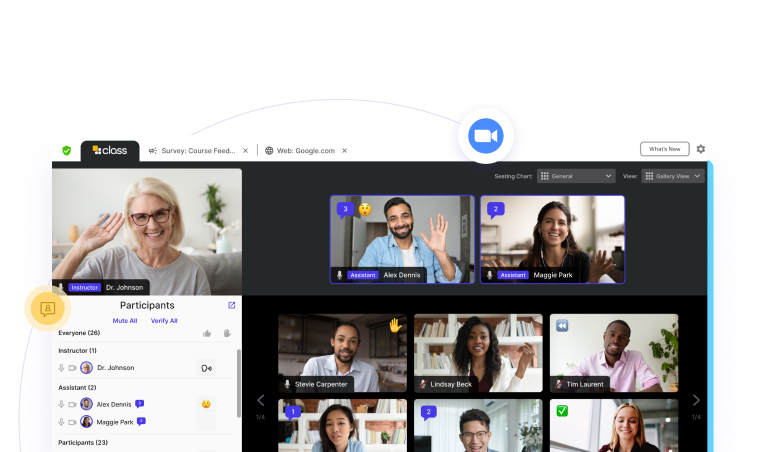
Devon Szklennik is a Senior Account Executive at Class, where she partners with educational institutions across the country to enhance their online learning experiences. Focusing on innovative solutions for synchronous learning, Devon works closely with colleges and universities to help them leverage Class’s tools to improve student engagement and faculty efficiency. Drawing on her extensive background in education technology, Devon is passionate about empowering educators to create dynamic, interactive virtual classrooms that meet the evolving needs of today’s learners.

Devon Szklennik is a Senior Account Executive at Class, where she partners with educational institutions across the country to enhance their online learning experiences. Focusing on innovative solutions for synchronous learning, Devon works closely with colleges and universities to help them leverage Class’s tools to improve student engagement and faculty efficiency. Drawing on her extensive background in education technology, Devon is passionate about empowering educators to create dynamic, interactive virtual classrooms that meet the evolving needs of today’s learners.

While virtual learning environments are continuing to expand across higher education, there is a growing concern about the disengagement and lack of motivation many students are starting to experience with this mode of learning. A study conducted by Barnes & Noble College Insights found that 64% of students surveyed expressed concern over maintaining focus and discipline in their online courses.
“Zoom fatigue,” online distractions, and difficulties making meaningful connections leave many students feeling disconnected from their studies. While many are pointing the finger at technology being the problem, it can also be the solution.
By thoughtfully designing interactive and engaging lessons that leverage the right tools, educators and curriculum designers can create experiences that counteract fatigue and inspire engagement. In this post, you’ll discover more about how the strategic use of technology can redefine the student experience, turning virtual classrooms into dynamic spaces for collaboration and learning.
Virtual fatigue in higher education has become an all-too-familiar challenge, but what does it really mean, and what’s causing it? At its core, it’s the physical and mental exhaustion that students experience from continued use of digital learning tools, combined with a sense of disengagement from and a lack of connection with the course material, peers, and instructors.
Here are three of the bigger factors contributing to virtual fatigue in higher education.
Online learning, especially in extended sessions, can take a toll on both the body and mind. Prolonged screen time can lead to eye strain and headaches, while the absence of face-to-face interaction can cause students to feel isolated. The monotony of staring at a screen without the dynamic energy of in-person connections can make it harder for students to stay engaged or motivated.
Tools like Zoom and Microsoft Teams are commonly used in online learning, but they don’t provide the best environment for active engagement. These platforms are designed for meetings, not interactive learning, and they can unintentionally encourage passive participation, which leads to disengagement. The lack of features specifically tailored to education, such as collaborative whiteboards, real-time group work, or dynamic breakout activities, can make learning feel more like a lecture than an interactive experience.
Many students enter virtual learning expecting a collaborative environment where they can interact with their peers and instructors. In contrast, the reality often falls short. Lectures tend to dominate, and opportunities for real-time interaction and collaboration are limited. This mismatch between expectation and experience can leave students feeling unfulfilled and ultimately lead to fatigue.
In spite of the challenges associated with it, virtual learning continues to proliferate, as 75% of undergraduates and 71% of graduates take at least one online course during their education. Because of this proliferation, colleges and universities must adapt to a new approach that prioritizes both engagement and motivation.
First, work to change perceptions. Online education can no longer be seen as a “less than” alternative to in-person learning. In fact, when designed thoughtfully, it has the potential to offer dynamic, interactive, and even more personalized learning experiences that leverage real-time insights hard to capture in traditional classrooms.
Institutions need to rethink their approach to course design. Lectures have their place in instruction, but there needs to be a balance. A well-rounded virtual classroom should feature both lecture-based content and interactive, hands-on learning activities that create engagement and reinforce course material.
To make virtual courses truly engaging and meaningful, focus on designing courses to be interactive experiences that inspire students to actively participate in their learning. Start with the following strategies, designed to help you make online learning more engaging and impactful.
After you’ve laid all the groundwork to make your courses engaging and interactive, you want to make sure you’re tracking key metrics to ensure they stay effective and that you can improve them over time. Determine the metrics you need to measure success, like participation rates, completion rates, and student feedback. Implement regular feedback loops with students through surveys, polls, or informal check-ins, which will allow you to refine your approach and continually enhance the virtual learning experience.
Virtual learning doesn’t have to be synonymous with fatigue. With the right strategies and tools, we can transform online environments into vibrant, engaging spaces where students thrive. The key is not to blame the mode of delivery, but to continually experiment with new approaches and technologies to keep students motivated and excited about their learning. Instructional and technology leaders play a vital role in this process, continuously refining their methods to meet the evolving needs of students. By staying adaptable and proactive, you can create virtual experiences that inspire students for years to come.
Ready to create a more engaging virtual learning environment? Connect with a Class expert today to learn more about how to implement these strategies and tools in your courses.

Devon Szklennik is a Senior Account Executive at Class, where she partners with educational institutions across the country to enhance their online learning experiences. Focusing on innovative solutions for synchronous learning, Devon works closely with colleges and universities to help them leverage Class’s tools to improve student engagement and faculty efficiency. Drawing on her extensive background in education technology, Devon is passionate about empowering educators to create dynamic, interactive virtual classrooms that meet the evolving needs of today’s learners.

Devon Szklennik is a Senior Account Executive at Class, where she partners with educational institutions across the country to enhance their online learning experiences. Focusing on innovative solutions for synchronous learning, Devon works closely with colleges and universities to help them leverage Class’s tools to improve student engagement and faculty efficiency. Drawing on her extensive background in education technology, Devon is passionate about empowering educators to create dynamic, interactive virtual classrooms that meet the evolving needs of today’s learners.
Get our insights, tips, and best practices delivered to your inbox

Sign up for a product demo today to learn how Class’s virtual classroom powers digital transformation at your organization.

Features
Products
Integrations